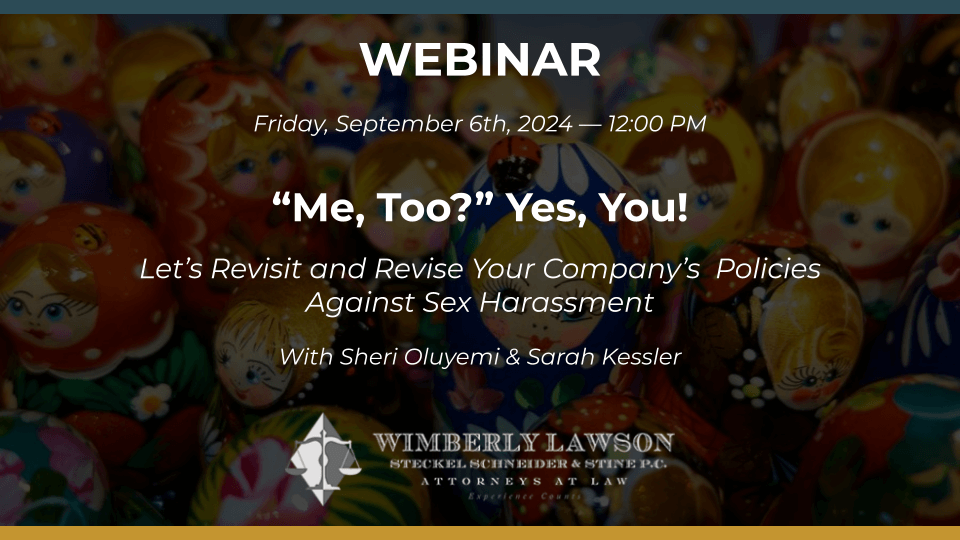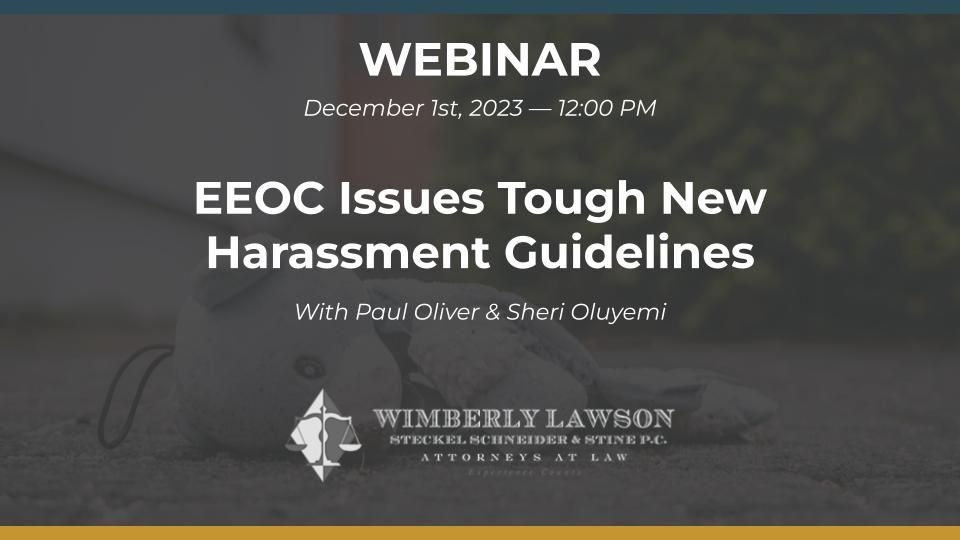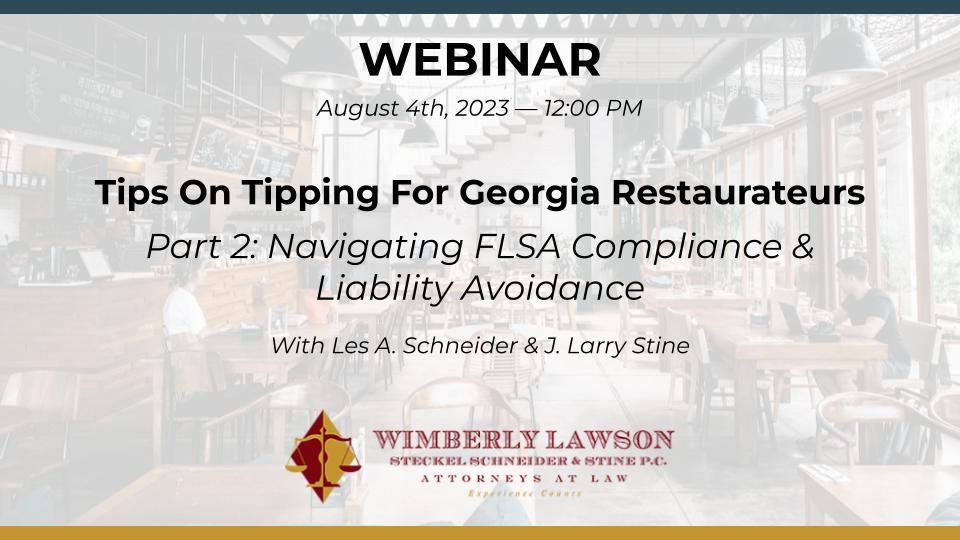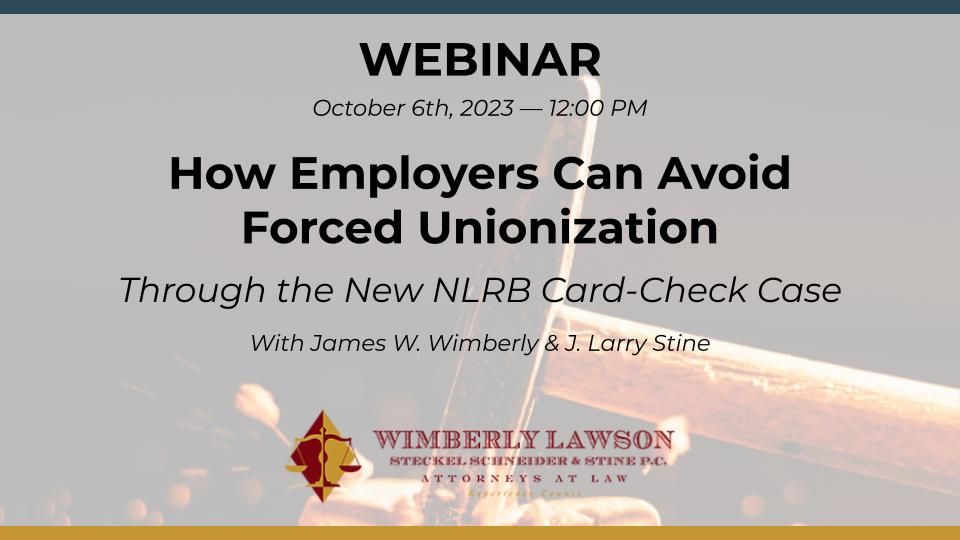
“Me, Too?” Yes, You! Let’s Revisit and Revise Your Company’s Policies Against Sex Harassment
A Critical Look at Sex Harassment Policies and How They Might Be Improved.
When was the last time you looked at your company’s policies prohibiting sexual harassment, and procedures for processing complaints? This seminar serves up food for thought based on recent developments in the law, society, and technology. Join us for some practical pointers on reevaluating and updating policies that can help your enterprise stay out of trouble.
Watch This Webinar
Webinar Transcript
Sheri Oluyemi (00:00):
Good afternoon everyone. Thank you for joining us on another webinar here at WIM Law. Today we're going to be looking at the sexual harassment policies, and I'm sharing my screen, so I hope everyone has a clear view of the slide. I think I might be able to share video as well, but I'm not entirely certain. Okay. See both the video and the slides. Oh, perfect. Excellent. Okay, so we're in good shape. Again, thank everyone for joining us this afternoon during your lunch hour. We hope over the next 45 minutes to cover a critical look at harassment policies.
Sheri Oluyemi (00:50):
Next slide. So we're going to go over background, legal landscape, both federal and state, and then we'll get into the nitty gritty, the meat of the webinar, which talks about the harassment policy and procedure components. There are various components that we shall cover some of which are listed here, prevention, detection, detection, investigation, correction. And then at the very end of the webinar, we will open the floor to some q and a. Just a little bit of housekeeping to let you know how we'll conduct the q and a. You have an option of raising your hand using the icon at the bottom of your zoom screen, and we will call on you. We will unmute your mic and you can ask your question to the group. And we will offer some of our advice, not legal advice, but legal information. Name that forum, or you can put your question in q and a box also at the bottom of your zoom screen that'll come directly to Sarah and I and we shall respond either to the group or if it's a very specific question to your workplace, we might ask you to take the question offline.
Sheri Oluyemi (02:10):
I don't recommend using the chat option, but that's an option too. Just make sure that you're sending your chat to the host and the panelists. So make sure that little button on top shows that you're sending the chat question to us so that we could see it. I realized that I skipped right through introducing myself as though you already know who I am. <Laugh>. My name is Sherry Oluyemi. I am a labor and employment lawyer here at WIM Law. Been with the company now going on three or four years. And I practice the full gambit of employment law, focusing specifically on civil rights. So your Title vii the FLSA, so that's the wages over time, and also osha, which is Occupational Health and Safety. Sarah, would you like to introduce yourself?
Sarah M. Kessler (02:59):
Sure. Hi my name is Sarah Kessler. I've, I'm also an attorney here at Wimberley Lawson. I've been working here for a little under two years now. Before that I worked at the Patent and Trademark Office and I also worked in a plant as an engineer for a little while. So I do a little bit of everything here, OSHA and the Labor and employment law, some other sort of contract stuff.
Sheri Oluyemi (03:27):
Excellent. And it'll be our pleasure to take you through the topics today. I will kick it over to Sarah to get us started.
Sarah M. Kessler (03:36):
Okay. so we're gonna go through the background, sort of why you're here why this is important to you. So first of all, employers are liable for sex harassment by owners, managers, coworkers, and even customers. So any of those can affect you. You need to be kind of on the lookout for all of these sort of different things and just, you know, make sure that you are not sort of letting this go and just sort of pushing it aside. So why do you, why do you care as an employer or a company? So this liability can result in site significant financial and reputational damage to the business. So sexual harassment in your workplace can open you up to to legal claims where you may have to pay damages and also the reputational damage kind of both internal, external. You don't want your employees to think of you as an employer where harassment happens and is allowed. And you also don't wanna end up in the news as a company who allows harassment to, to go on that can, you know, damage your company in multiple ways, ways. So through this presentation today, we want to equip you with the knowledge and strategies to proactively address harassment, minimize risk, and create a safe and respectful workplace.
Sarah M. Kessler (05:14):
So what are the legal things that you need to be concerned about? First of all is Title VII of the Civil Rights Act. Now this from the government's website, title VII protects employees and job applicants from employment discrimination based on race, color, religion, sex, and national origin. This covers recruitment selections, terminations, and other decisions concerning terms and conditions of employment. So you have to be concerned about this not just in, you know, the day-to-day of what's going on in your workplace, but also in recruitment, hiring decisions, that sort of thing. There are also state law harassment claims. So every state is different, obviously. So we're not gonna, you know, list everything that you may be concerned about here. But you should be aware of the state laws in the states where you operate, so where your headquarters is, where you have employees, the Equal Employment Opportunity Commission. So they actually just published some guidance on harassment in the workplace. This was published in 2023, and the final guidance was issued in April of 2024. This is fairly easy to find online. It's a somewhat lengthy document, but there is some good information in there on sort of what is expected of you as an employer on different types of harassment, including sex harassment.
Sarah M. Kessler (06:55):
And then also want to be concerned with state-based civil rights organizations. So, you know, they can bring claims or, you know, just raise concerns about the things going on in your workplace. So what is required of you as an employer? So you need to have an anti-harassment policy, procedures and training. You want a robust policy, clear complaint, procedures, and comprehensive training. Employees must understand their rights and responsibilities and you need this so that you can establish a proactive defense against harassment claims.
Sheri Oluyemi (07:48):
All right, so let's get into what we should have contained in that anti-sex harassment policy procedure and training. The first prong is, of course, preventing harassment. There is no better defense than to take the issue head on before it even begins. So we recommend that employers have a policy that addresses ways to monitor the workplace. Now, when I say the word policy, there are two types. There can be an HR handbook, an employee handbook, or an employee manual whatever you call it at your organization that is issued to the employees. And this will give them specific instructions relevant to their workplace. Then there are also what some companies have, which is a supervisor's manual or a training guide for the supervisors only. And if your organization has it should have at least one, so at least the employee handbook, at least that HR manual.
Sheri Oluyemi (08:51):
But some companies will also have a supervisor's guide or a supervisor's handbook that'll have additional information specifically for your managers, for your supervisors that you use in training. Again, it's not required to have both, but we certainly do recommend that you do have at least one that is applicable to the entire workplace. So for the issue of monitoring the workplace, this is more for your supervisors. I feel as though supervisors are the first line of defense. They see what's going on between employees. They know your employees a lot better than you do sometimes, and they should be equipped with how to recognize what harassment is. So we recommend that you train your supervisors to be mindful of those things. They are probably already well aware of, for example, health and safety issues, and they will draw your attention to those obvious health and safety hazards. The same should be true of harassment. Get them into a mindset of GE generally and regularly recognizing when these issues are going on in their groups, their teams on their lines, et cetera.
Sheri Oluyemi (10:06):
So once your supervisor has been trained to recognize these issues they need to, they would benefit from also learning to recognize specific circumstances that are more likely to lead to trouble. Some of the factors we've listed here are isolated workplaces, vulnerable employees, and power imbalances. And I think this is a good opportunity to really teach your supervisors what harassment is and what harassment is not. Trust us, we get the full gambit, you know you know, my supervisor put me on a pip, not quite harassment. Your supervisor's job is to manage your performance, but things like pet names, some examples I've listed in my notes, you know, honey dolls, sweetheart those types of pet names can be viewed as harassment from an employee who's not welcome to receiving that. And this, the, those are verbal examples of it. Physical harassment, of course, unwanted touching, rubbing hugging is a, is a big one.
Sheri Oluyemi (11:11):
Some people just show affection through hugs and it's just platonic for them. Whereas others who may be on the receiving end of that conduct may view it as harassing. So your supervisors should be taught specifically what is harassment in your workplace? Because we all come from different backgrounds, different workplaces, different families, different training. It's important for you to teach your employees what your standards are. And so don't bypass this in your training. Make sure you, you list, and it's not gonna be an exhaustive list, but at least give the supervisor or the manager what to look for. And then of course, I've covered verbal harassment, physical harassment, there's visual harassment as well. These are displays of sexually explicit content posters, sometimes music that's playing on the radio. Again, from one person's per perspective, it might just be art. And from the other person's PERS perspective, it's unwelcome and it's harassing.
Sheri Oluyemi (12:12):
So we recommend training your supervisors to identify these situations. Alright, so once the supervisor has recognized these, these issues then you would have other duties that arise afterwards. But I wanted to flag this here from the EOC, they state that an employee can be liable for harassment if it fails to correct the harassment that it not only knew, but should have known about. This is an issue that became highlighted in the EOC guidance that Sarah referenced earlier. The EEOC is now focusing on harassing situations that the employer should have known about. Even though there's not been any formal notice, even though there's been no complaint, the EEOC is now focusing on situations where it believes the employer should have known better. So we're gonna spend some time talking about what is notice. A lot of you already know what notice would be generally when it comes from the quote unquote victim, Hey, this thing has happened to me, this person said X, Y, Z.
Sheri Oluyemi (13:22):
Sometimes notice comes from a third party like Sarah Mentor mentioned. It might be a customer, it might be a vendor, or it might be observed directly. A supervisor may have overheard something, a manager may have overheard something. Ordinarily, failure of the employee to provide notice to the company is a defense to where a coworker harassment. If the employer didn't know that your linemate was hitting on you, then the employer cannot take any action about it. So the employee must give notice to the employer. Otherwise there is a full defense. However, the EOC has stated now that the employer has notice when someone who is responsible for reporting harassment or addressing harassment is aware of it. So to go back to my example, if the supervisor overhears a manager who is propositioning, a subordinate or a coworker who's doing the same, the fact that the supervisor overheard that does not free the employee from notice.
Sheri Oluyemi (14:23):
In that situation, the employee, the employer from notice, in that situation, the employer would've had notice because a supervisor or an HR manager overheard the conversation. So your managers and supervisors can no longer wait for that employee to report the harassment. If it's ongoing, it appears to be unwelcome, then the employer is formally on notice and would be required to do something about it. So these are the two concepts that I've just sort of talked about. Actual notice when it comes directly to the employer from someone saying, this is what happened. And then constructive notice when there's situations where the employer should have known, and this can occur when the harassment is severe or widespread. If there's a culture that's forming around it, I'll give you another example. The the playing of music in the workplace. If there's a routine where someone comes to work, they turn on a particular radio station, and this is going on day after day after day after day, and not everyone's enjoying listening to that music, then the, the supervisor or the manager would be on notice that this is now creating a hostile environment for certain ty types of employees, maybe the women in the group, the men in the group.
Sheri Oluyemi (15:40):
And it's becoming a problem. And I guess now that I've touched on that, when you train your supervisors, they should be aware, of course, that sexual harassment is not just male and female. It can be any spectrum of the gender spectrum. So they should be aware that they're not only looking to prevent harassment between the heterosexual group, but from a now broadening spectrum of what is defined as sex and gender.
Sheri Oluyemi (16:16):
All right? Okay. So once the employee employer has been put on notice, what is the employer required to do? The first step is investigation, and the ultimate goal is to prevent a recurrence of the issue. So let's talk deeper into investigations. An effective investigation has many qualities, and I've listed a few here on my slide. Definitely not all of them. But one of the key ones is the promptness. The employer should endeavor to have a prompt investigation. So it should begin as quickly as possible after the employer is on notice. And it should also be prompt in its completion, meaning it shouldn't take too long to get from the start to the end, and an investigation that drags out over many months or over many weeks. Unless that can not be avoided, perhaps the employee who's at issue is on leave, and that causes the amount of time of the investigation to take a long, longer time. That's an exception. But generally, the investigation should be prompts begin immediately after the complaint, and it should wrap up as promptly as possible.
Sheri Oluyemi (17:38):
And then the, the investigation should be adequate. We recommend that you have someone impartial conduct the investigation if it is a serious complaint. Someone impartial could be an attorney, it could be a consultant who does these types of investigations, or it could simply be another manager from another department. And the reason for impartiality, you may already know, is to avoid things like retaliation to avoid bias. Another good point to mention at this juncture is the reporting structure. A lot of HR policies will say, report the harassment to your supervisor, report it to your manager. There are situations where those various supervisors or managers are the perpetrators of the alleged harassment. So your handbook or your manual should als always give an alternative route of reporting. The EOC guidance goes even so far as to say that the employee can report it to anyone.
Sheri Oluyemi (18:40):
I don't believe it's that broad. I don't believe the courts will, will sustain that broad of a requirement. I believe that in the handbook you should have, you know, your direct reports, definitely. And then if for whatever reason your direct report is not an appropriate person to report to, an alternative, so a manager in another department if you have a hot hotline for complaints, you can put that in your handbook, call the hotline, here it is. Or you have in-House Counsel, talk to in-house counsel, you have someone who's head of compliance. Talk to someone who's head of compliance, provide those options in your handbook. And this is important for defenses because we can show a judge we did not have notice, even though the employee had all these options to provide notice to someone that they felt comfortable with. So yes, it goes back to the investigation. It should be impartial by using someone who's perhaps not directly in the chain of command.
Sheri Oluyemi (19:44):
And other traits of an effective investigation include documentation. If you've been to our webinars, you'll hear us say over and over and over, document, document, document just for posterity, stakes sake, so that we have evidence of contemporary its notes, things that were created at the time of the investigation, as opposed to the week before. We have to file a defense to a motion for summary judgment or file a motion for summary judgment. If the document was created, created at the time of the investigation, it's going to have more credibility. It might be more complete. Memories are fresh at that time. And so when you conduct your investigations, they should be documented. Here is something I recommend putting in your supervisor's, training and, and manuals. Forms that are designed specifically for the investigation, the date these notes were taken, person I spoke to, any witnesses, any documents that were provided to me during the investigation, have a form so that the person conducting the investigation always checks all the boxes.
Sheri Oluyemi (20:49):
Again, the date of the conversation, the, the person being interviewed, any witnesses to the interviews, and any documents that were provided to the investigator by the interviewee that goes in a file somewhere. And you'll always have it should an issue come up. And if it doesn't come up, then you can recycle those notes, but at least you'll have that defense if you, if you need it. So documentation for investigation of sexual harassment complaints are critical. And now that audio recordings are very pervasive in the workplaces, if there is an audio file, save that as well. If you can have it transcribed. Microsoft Word will transcribe an audio, an audio recording save the transcription. That way if something happens to the recording, you have the transcription and you'll be able to preserve that evidence that way. Communication. So here's a hot topic for investigations.
Sheri Oluyemi (21:43):
How much can you tell ev anyone about the investigation? Ideally, confidentiality is best, and confidentiality is great because it, it fights against retaliation. It is your best defense to someone saying, well, he retaliated against me because I complained. He didn't even know about the complaint. So confidentiality is huge. Of course, it can't always be maintained. If you need to interview the accused, then the accused is going to have notice of the complaint. And sometimes that cannot be avoided, but you can keep the circle as small as possible, only those who need to know. There's no reason to discuss a sexual harassment investigation after your Wednesday, you know, management meeting that happens every Wednesday for all the managers. That's just too broad of a circle and it it opens the employee up to retaliation or or other, those concerns about privacy. So we recommend keeping it on a need to know basis as much as possible.
Sheri Oluyemi (22:48):
And also do not promise confidentiality to the employee. If you cannot maintain that I would say just tell the employee that it will be kept as confidential as possible, but for example, we need to speak with witnesses and therefore we will be interviewing x, y, Z to get some corroboration. At the end of the investigation, you may want to send a note to the complainant to let them know that the investigation has been concluded and that it's either substantiated or unsubstantiated. Generally, what we do is to just tell the complainant that the investigation has concluded and any appropriate corrective action has taken place. That's the extent of really what you need to tell them, because you have to respect the privacy of the employee who may have been reprimanded as a result of the complaint. But we do recommend giving the complainant some notice of the fact that the investigation has concluded.
Sheri Oluyemi (23:45):
If you leave it open in their eyes, they don't know whether it's over or not, they're more likely to run to plaintiff's counsel to say, you know, this investigation was taking place and it's been months and I haven't heard anything. So you do wanna go back to communicate to the complainant that the investigation is concluded. And if there's someone who has been accused, let them know, you know, this has been substantiated and we're taking x, y, z disciplinary action against you, or, this has not been substantiated. And remember not to retaliate against the complainant. Something like that. To close the, close the circle and put this behind you is, is highly recommended.
Sheri Oluyemi (24:29):
Alright, correcting harassment. Just make sure I didn't skip anything. Oh, wait. So your investigation is concluded at this point, and you have determined or you are determining whether or not to take corrective action. First consideration I have appear is proportionality the response should match the severity of the offense. Often I see a situation where the complainant is disciplined even though the even though the complaint is substantiated. And I, I never understand that if someone has complained in good faith and the the harassment is substantiated, then the complainant should not have any adverse action taken against them. Things that they view as adverse action could include an unpaid leave or a suspension even during the period of investigation. Some employers will put the complainant on an unpaid leave looking at it from the complainant's perspective, that looks like an adverse action because now they're out of work unpaid and they're worried about their reputation and rumors that are going on in the office.
Sheri Oluyemi (25:50):
So as much as possible the complainant should not have any adverse action taken against them or any action that can be perceived as adverse while you're conducting the investigation and after the fact. Unless, of course you find that the complaint was not made in good faith, in which case, and this is something that should go into your policy, a warning that complaints should be made in good faith. And if there is a finding of a lack of good faith, disciplinary action against the complainant is appropriate for the person being complained of. It is typical to put that individual on leave during the period of the investigation. If it is an unpaid leave and the investigation turns out to be unsubstantiated, you may reinstate that employee with back pay for the period of time that they were out of work because of this investigation.
Sheri Oluyemi (26:46):
Sometimes the period they were out of work is sufficient for a suspension if the complaint is substantiated. So you would bring the employee back to work and let them know that the time they'd spent away from work without pay was the suspension and now they're being returned to work. Try to be proportional with your, with your responses. Minor offenses might be counseling. Again, document. So even if the counseling is verbal, there should be a memo to file that, a verbal warning to place. Where there are verbal warnings, people believe, well, nothing needs to go in the file. I don't entirely agree with that. I would, I would argue that there should be a memo that says a verbal warning took place. So that if you have a progressive discipline policy in your handbook, you know that you've met the, maybe the first stage of that discipline by issuing a verbal warning.
Sheri Oluyemi (27:41):
Have the employee sign off on it as much as possible, stick that in the file. More severe harassment may require termination. Again, just because your policy has a progressive discipline plan in it, it doesn't mean that there are no situations that warrant immediate determination. There are situations that require you to terminate on the spot without going through all the steps of progressive discipline. And we would recommend that you, you know, you use your discretion as to when to apply that course of action. And also to be careful to always apply that course of action uniformly to all employees regardless of their protected category.
Sheri Oluyemi (28:28):
Effectiveness we talked about at the top of the hour, the goal here is to prevent the harassment as much as possible. And then if it does happen to prevent a recurrence, so whatever correct corrective action you choose to take it should be effective to make sure that the harassment stops. And if it's not effective, we would recommend that you go in again, reassess and see what other measures can be taken. What other measures can be taken to prevent the, the harassment. I talked about disciplinary action, but that's not the only route you could take. You could also provide training for the employee. You could refer them to outside resources for counseling if you believe that that's what they needed. And then of course, the disciplinary options. All of these are, are, could be appropriate corrective action depending on the situation that you have encountered.
Sheri Oluyemi (29:33):
All right, still on corrective action consider the impact on the complainant. Often I'll see employers offered to transfer a complainant out of a department to distance them from the harasser. Consider the impact on the complainant. Will that transfer result in a loss of wages? Will it result in a less favorable shift? Perhaps this person likes to start early and perhaps, or perhaps a person likes to work the night shift. Will your transfer cause any inconvenience to the complainant? Consider that if possible, give them, give them a chance to give input on the corrective action that you plan to take if it is going to impact them. Of course, if they volunteer for a transfer, that's excellent. Make sure you document that this option was provided to the complainant and they selected a transfer, even if it's resulting in some sort of adverse action.
Sheri Oluyemi (30:34):
Maybe loss of like a premium for a, a more desirable shift. Note that this was discussed with the complainant and they are in agreement place that memo into the file, and again, to avoid actions that could be perceived as retaliation. Your handbook will talk about retaliation over and over again because it is, according to the EOCs website, the largest number of EOC charges that it receives are retaliation. The most lawsuits against employers for breach of civil rights laws are retaliation. It's a, it's a lower hanging fruit because it just has three elements, and once those three elements are, are, are met, then it's very difficult to, to overcome the burden by showing a nont retaliatory reason. So think about the impact on the complainant to avoid anything that could be perceived as retaliation.
Sheri Oluyemi (31:36):
All right, I'll just make sure I covered everything on retaliation before we go to the q and a. Of course, retaliation could result in another cycle of notice investigation and corrective action. If there is a retaliatory event that that occurs and is reported to you, then the cycle will cycle. That will start the cycle again. Once the employer is on notice that there's a potential for retaliation, an investigation should take place, going through those elements that we've covered as to what an effective investigation looks like, and then again, corrective a action to prevent it from happening again. Some of those could be a transfer to separate the two employees. Some it might require termination of the employee that has acted in retaliation. But essentially that starts the whole cycle again to talk about, to talk about what you need to do to address the, the retaliatory conduct.
Sarah M. Kessler (32:42):
There we go. Shelly, if you wanna ans ask your
Speaker 3 (32:45):
Question. So quick question for you on the timing, the specific timing that HR needs to turn around an investigation on alleged claim. I know it's always like fast and as soon as possible, but is there a specific timeframe like within 24 hours, within a day, two days, or what are, what would they look at there?
Sheri Oluyemi (33:05):
Yeah, so again, there's no, there's no bright line rule. There is no deadline. The, the laws generally say it should be prompt, which means as soon as possible. Sometimes it's not possible to turn around a, a investigation in 24 hours. Like I said, if the employees are out and you need to speak with someone, if someone's on, you know, sick leave disability, leave FMLA, you don't wanna be calling them to conduct an interview. So you may have to put the, the investigation into a, a longer term than, than 24 hours. But if you have all the employees there, for example, an incident that happens today in the morning and all the employees are available, I would schedule interviews with them that day and see how many you could speak to while everyone is, you know, while the incident is fresh in everyone's mind.
Sheri Oluyemi (33:58):
And then perhaps if you have a team within your HR department and you want to discuss it, that's something that can happen the same day as well. And then you render a decision the following day. So 24 hours is possible, and if it's possible, we recommend that you, you do do that. But again, there's no bright line, bright line rule. There's no fixed deadline. It, it really depends. I think the courts would look at the availability of witnesses as being an important factor as to why it took you long or not so long to, to to address an, to complete an investigation. I'm thinking of one case where it was a hospital and they took four months, but the investigation started the week prior to COD. And so as you remember, hospitals were overwhelmed during that period of time. And so a judge could look at a four month long investigation and think, given all that was going on at the hospital at that time, it is excusable. The employer was not negligent or the employer did not drag their feet and they addressed it as quickly as they could in that context. So I guess the, the only information I can give you is just to confirm that there's no test. Now some policies, I have seen some employers put in their policy, we will get back to you on a complaint within X number of days.
Sheri Oluyemi (35:25):
I don't know if I'd recommend that. Sometimes it's not possible. Perhaps you, if you have that in your policy, you include a qualifier and say, we will endeavor to, to get back to you within X number of days to the extent as possible given the circumstances at the time, something like that. So that your supervisors and your managers have that three days maybe in their minds and they, they work towards a three day deadline. But you also have some cover in the handbook. So the complainant knows that it may take a little bit longer. And, and I have seen that in a fair number of handbooks. Again, I do not recommend promising X number of days or x number of hours. Sometimes it's just not possible. But again, the guideline might be helpful for managers and supervisors to keep that in mind so they can try to, you know, move quickly and maybe wrap it up in three days that it might help for them to know at X company we would like to conclude investigations within X number of days. And maybe that's something you include in their training. But I, I don't know that I'd recommend putting that in the handbook. It just binds your, it binds you a little bit.
Sheri Oluyemi (36:43):
But that was a great question. I know the duration of an investigation can be a contentious issue.
Sarah M. Kessler (36:53):
Are you any
Sheri Oluyemi (36:53):
Other questions, Sarah?
Sarah M. Kessler (36:55):
I do not see any others. So I have a question. So you talked about a progressive discipline program. So what are some examples of steps that an employer might wanna put in that kind of a, a discipline program?
Sheri Oluyemi (37:12):
Well, typically we usually start with a verbal, which is a counseling conversation between the employee who's being disciplined and their immediate supervisor perhaps in the presence of hr or just with hr, with the supervisor being absent, depends on the circumstances. You need to use your discretion as to who is present during that verbal counseling, it's helpful to have a witness yes, but even more helpful than that are notes. So that's the first step. And then of course, the written warning where it might have a little bit more detail in the memo. And the memo is issued specifically to the employee placed in their employee file. After the written warning, there can be a suspension either starting at 24 hours or for however long the policy states, and then of course after the suspension it's termination. That's typically the steps that I see for progressive discipline.
Sheri Oluyemi (38:08):
And it's, it's a good idea to include that in your handbook because juries love to see when the employee has been given due process. Yes, we know that in Georgia it's an at will state, but when you're facing a termination lawsuit and you're facing a jury, they wanna know that you gave the employee fair chance that they had notice of what was expected of them, that they had received this anti-harassment policy, that they had been trained on the anti-harassment policy. And then that when they breached it, perhaps the first time you gave them some step on your progressive discipline policy, and then when they breached it, the second time they were terminated, a jury is more likely to nod their head and say, okay this individual had notice and they had a chance to behave appropriately and they were trained and they still didn't do it. It's extremely helpful to, to have that progressive discipline plan and to walk the employee through it.
Sarah M. Kessler (39:06):
Okay. we do have a question. Yes. it says, if the results of the investigation are not substantiated, do you recommend telling the accused those results?
Sheri Oluyemi (39:20):
Well, I would, I would tell the accused that the investigation is concluded and there are no further steps needed to take or the, the investigation is concluded and there's nothing further required of that individual that's saying that it's unsubstantiated without saying that it's unsubstantiated. You can either issue a blanket statement such as that to the accused and I, and I would recommend telling the accused something, or you could say the investigation is concluded and you know, or just saying the investigation is concluded and, and just end it there. And if the complainant, I mean the accused is not receiving any disciplinary action, they'll understand that it was, it was un unsubstantiated.
Sarah M. Kessler (40:20):
Do you notify the complainant?
Sheri Oluyemi (40:22):
I would notify the complainant that the investigation one, that it took place because a lot of complainants will doubt that you actually looked into it. And two, that it was, well, I would say, and any corrective actions have been taken if needed, I would put it that way. The investigation is concluded and any necessary corrective actions have been taken as appropriate. That is the typical response we give complainants because it covers a situation where it is substantiated, it covers a situation where it's unsubstantiated and it lets the complainant know that the, that it's, that it's over. Now, of course, if there, if there is a need for, for example, a transfer of that employee, then you would have to go into a little bit more detail. Here's where, here's what we've uncovered and this is how this person this is how we're going to address it. We're offering you a transfer to X department. I would involve the complainant a little bit more. If you're, if you're going to take the action of transferring the employee either to a different shift, different location, different department, then I, I would recommend telling the complainant a little bit more than my general, you know, investigation's been concluded and any corrective action if needed has been taken.
Sarah M. Kessler (41:41):
I do have another question. Sure. So you know, we obviously talked about a company can be liable even if maybe a kind of lower level manager is informed of a complaint. Is there a good way to incentivize those managers to sort of run things up the chain and report them to HR rather than just sitting on that complaint?
Sheri Oluyemi (42:03):
Well, that would be part of their training. If the lower level manager has received a complaint, let's say direct complaint, so actual notice, they should be trained in no uncertain terms that they need to report that to hr. And that should be reinforced in their training every time. If you've received a direct complaint, under no circumstances are you to just ignore it, bring it up to hr and HR who has the training will determine next steps. I would reinforce that in the lower level manager or supervisor's training regularly. Now if it is something less explicit under that constructive notice category where the EEOC says, you know, someone who had the authority to address the issue should have known about it in that case it's a little bit harder for the supervisor to tell what's going on. If the supervisor is unsure, I think the training would be the same.
Sheri Oluyemi (43:02):
Go to hr ha have a conversation with HR about it. In terms of incentives, I think just, you know, being, trying to do their job should be incentive enough. But also maybe tell them about the risks. Tell them about why this is important and why the company is interested in is in uncovering situations that may seem small now, but might fester into a larger, more expensive legal issue. Perhaps telling them a little bit more about why it's, why it's important, why it's critical why they need to protect their vulnerable employees might incentivize them a little bit to adhere to their training. So yes, training is, is key. And you leave with just one thing from this webinar is that you need an anti-harassment policy on which your managers, supervisors, and employees have been trained and that it should have these key components about monitoring the workplace reporting harassment, investigating it once you've received that report, and taking corrective action if anything is found, it should have those components in various degrees of detail.
Sarah M. Kessler (44:20):
I think that's about it for us today. If you guys have any more specific questions that you don't wanna ask, maybe in front of the group <laugh>, you can contact either of us. Yeah. So if you guys have any more specific questions or something you don't wanna ask in front of everybody, you can send that to either or both of
Sheri Oluyemi (44:39):
Us. Awesome. Thank you everyone. I hope you have an excellent weekend.





